SNAKES
There are some 2,700 snakes known in the world today. Snakes inhabit all the continents except Antarctica. There are 11 families of snakes in all, five of which have representative species in the United States. In Pennsylvania, two families appear, with 16 genera accounting for 21 species; only three of these are venomous.
EASTERN WORMSNAKE
Carphophis amoenus amoenus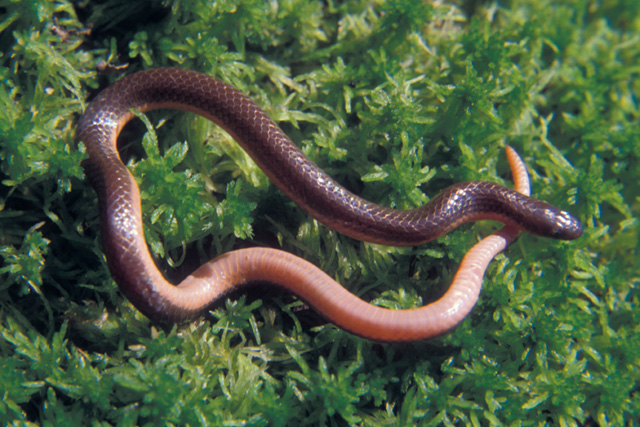
It's easy to understand how the eastern wormsnake got its name. It resembles an earthworm and isn't much larger when you consider that adults reach only seven to 11 inches. It is one of the smallest snakes in Pennsylvania. The wormsnake is a secretive animal, rarely seen in the open. If you wanted to locate a worm snake, you would have to do some serious searching.
This snake is tiny and glossy in appearance. Except for the belly, which is a bright reddish pink, the eastern worm snake is brown and unpatterned over its entire body. The head is blunt and rounded and the tail is short with a sharp tip. The scales of the eastern wormsnake are smooth and contained in 13 rows. The anal plate is divided.
KIRTLAND'S SNAKE
Clonophis kirtlandii
ENDANGERED SPECIES
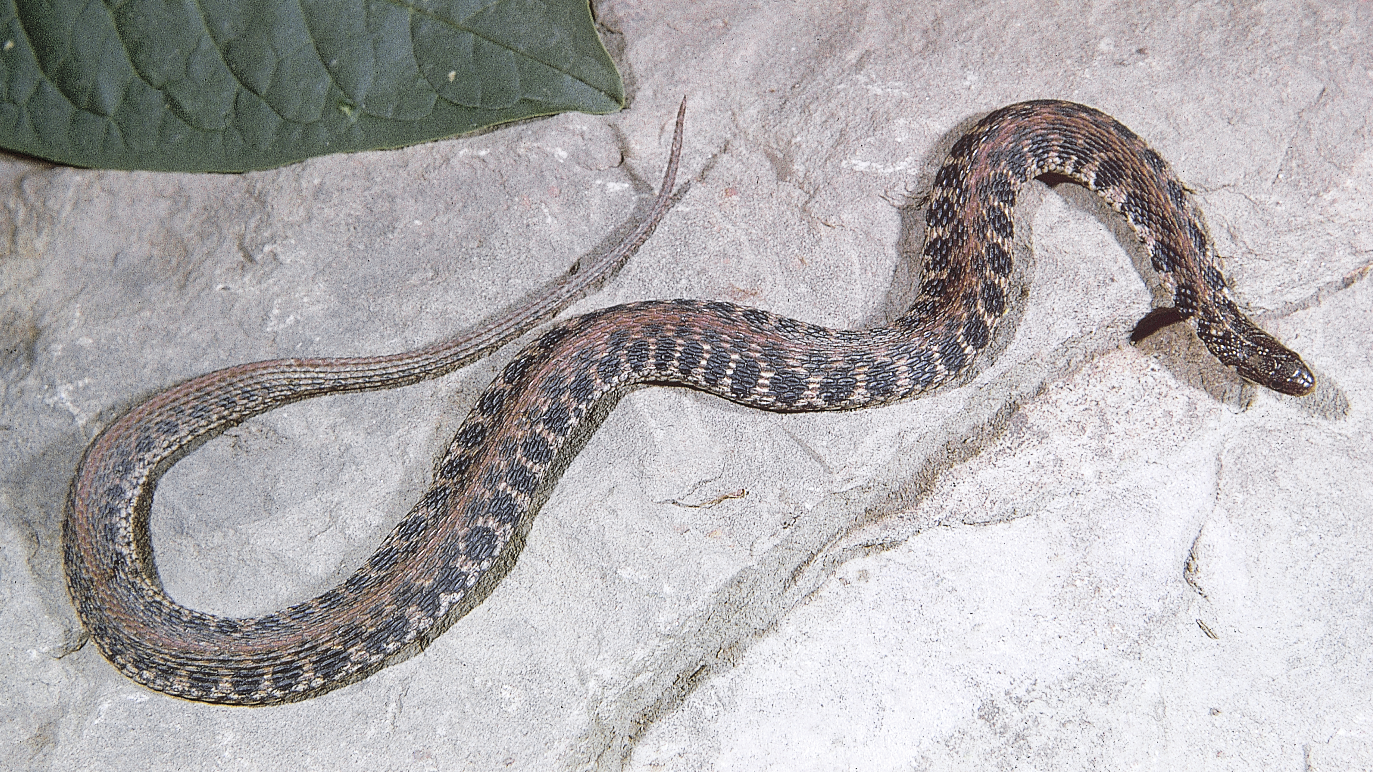 This snake is one of three water snakes in Pennsylvania, but it is found only in limited numbers and considered very rare. It was named for Jared P. Kirtland, an Ohio physician/naturalist. It is the smallest of the state's water snakes, attaining adult sizes of 14 to 18 inches. Kirtland's snake reacts in much the same manner as other water snakes when alarmed, except its reaction is more pronounced. When frightened, the defense mechanism is suddenly and swiftly to flatten their bodies to the ground. Kirtland's ability to perform this feat is more developed than other water snakes, becoming almost ribbon-like in the process.
This snake is one of three water snakes in Pennsylvania, but it is found only in limited numbers and considered very rare. It was named for Jared P. Kirtland, an Ohio physician/naturalist. It is the smallest of the state's water snakes, attaining adult sizes of 14 to 18 inches. Kirtland's snake reacts in much the same manner as other water snakes when alarmed, except its reaction is more pronounced. When frightened, the defense mechanism is suddenly and swiftly to flatten their bodies to the ground. Kirtland's ability to perform this feat is more developed than other water snakes, becoming almost ribbon-like in the process.
Kirtland's snake is a slender reptile with background colors ranging from brown to reddish brown or gray. The back is accented with two rows of alternating dark, squarish spots that run the length of the body. The belly is reddish and bordered along each side with a line of round, black spots. The latter is a good identifying characteristic, helping sort this snake from others that might have similar markings or reddish underparts. The scales are keeled and the anal plate is divided.
In Pennsylvania, Kirtland's snake is limited to the western portion of the state, roughly following the western slope of the Allegheny Mountains. From here it ranges west through Ohio into Michigan and Illinois and south to Kentucky. It does not extend into Erie County.
NORTHERN BLACK RACER
Coluber constrictor constrictor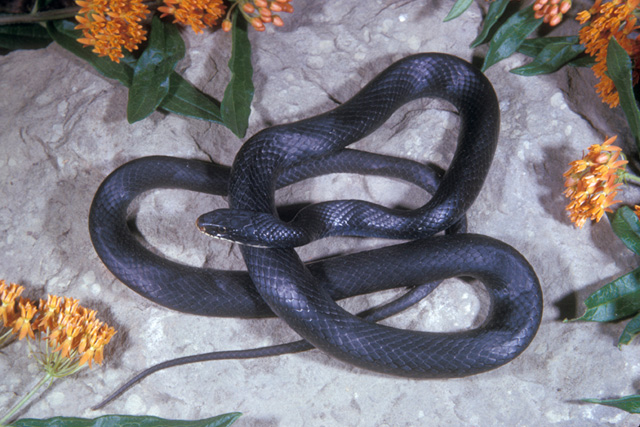
The northern black racer is often referred to as the "black snake" and is second only to the eastern ratsnake in size. It can attain an adult size measuring three to five feet in length. The northern black racer is diurnal, which means that it is most active during the day.
In spite of its scientific name, the black racer is not a constrictor. In fact, it is among several species of snakes considered non-constricting. If picked up, however, it does have a tendency to bite, sometimes repeatedly, and is apt to thrash about violently. The unusual habit of rapidly vibrating its tail against dry leaves has probably startled a hiker or two. One's first reaction to the buzzing sound produced as the tail strikes the crisp surface of the leaves is "rattlesnake." If nothing else, this false alarm heightens the senses of the trail walker. Although usually quick to flee, the black racer can become a fierce fighter when cornered or somehow made to feel trapped. Left to itself, it is harmless.
NORTHERN RING-NECKED SNAKE
Diadophis punctatus edwardsii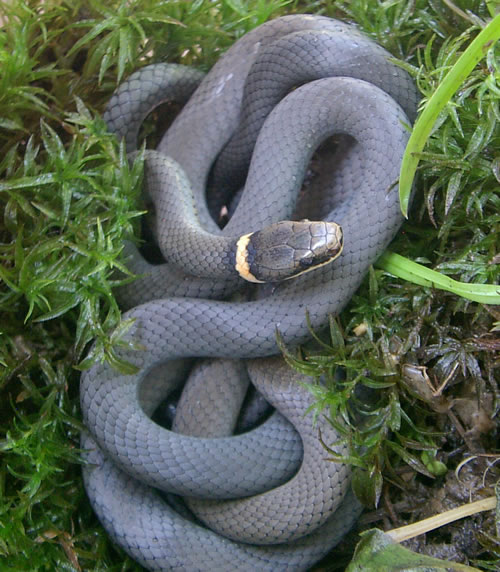
The northern ring-necked snake is a secretive animal, not often seen even by persons who spend a great deal of time outdoors. It usually moves about after dark, making it even less likely to be observed. This relatively small snake is harmless, although it can emit a pungent, unpleasant-smelling musk that may help repel an attacker.
The ring-necked snake in Pennsylvania reaches adult sizes of 10 to 24 inches while maintaining a slender build. Its distinguishing characteristic is the golden or yellowish ring that encircles the neck. The back and sides are usually gray but at times can be black or even brownish. The belly is almost always a uniform yellow, although at times it may have a center row of black dots. The anal plate is divided and the scales are smooth. The smooth scales help distinguish this snake from the juvenile northern brown snake, which also has a collar but which has keeled scales.
EASTERN RATSNAKE
Pantherophis alleghaniensis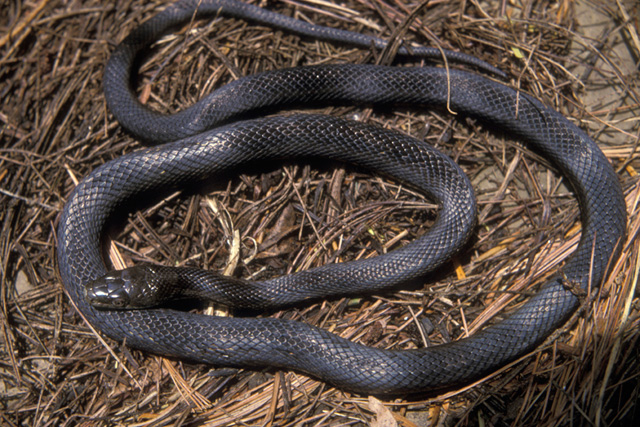
This is the familiar "black snake." The eastern ratsnake is the largest of 21 species generally recognized to be indigenous to the state. Adult lengths of 42 to 100 inches have been recorded. The eastern ratsnake is active during the day throughout the cooler months of spring and autumn. As the long days of summer grow hotter, it becomes more nocturnal in its movements, resting in a cool retreat as daytime temperatures climb. The eastern ratsnake is a powerful constrictor. It uses this physical strength to subdue its prey by suffocation. Musk glands located in the vent can emit a foul-smelling fluid, a defensive trait common among snakes.
The eastern ratsnake is plain, shiny black. The skin between its scales may be bluish white, yellow, red or orangish, although this coloration is not always evident. The belly of the eastern ratsnake is an even shade of white or yellow with darker mottling of gray or brown. The belly becomes more slate gray as it approaches the tail. The chin and throat areas are a toneless white or cream. The head is clearly defined in relation to the neck and body. A flattened snout seems to emphasize the head's squarish appearance. Also, the eastern ratsnake does not have the rounded or tubular body common to most snakes. Its belly is flat, meeting the sides at an angle. If one could imagine it viewed from the end, it would resemble a loaf of bread rather than appear circular. It has a divided anal plate. The scales are only weakly keeled.
EASTERN HOG-NOSED SNAKE
Heterodon platyrhinos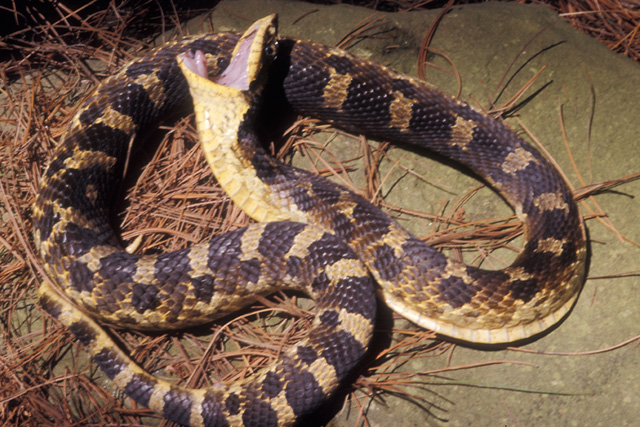
The hog-nosed snake has been pegged with several formidable-sounding nicknames: puff adder, hissing adder and spreading adder. All arise from a behavior contrived to scare off would-be attackers. When disturbed, the hognose snake widens its neck to take on a hood-like appearance. It does this by flattening the head and neck, spreading long rib bones outward. Then, inflating the body with air, hissing and striking out, the hog-nosed snake suddenly resembles a fearsome-looking creature, but it is harmless.
It alternates between playing dead and performing a series of aggressive-looking maneuvers that ultimately prove to be more of a decoy than anything else. If approached, the hog-nosed snake may attempt to fool the intruder by rolling over and "playing dead." A few convulsive jerks may first set the stage and then with mouth agape and tongue hanging out, the performance ends with the body frozen in place. If picked up, the snake suddenly goes limp. But returned upright to the ground it again quickly rolls over on its back, apparently forgetting it is "dead."
In Pennsylvania, the eastern hog-nosed snake resides in a major portion of the state, although it is not found in abundant numbers. Adult sizes vary from 18 to 45 inches.
EASTERN MILKSNAKE
Lampropeltis triangulum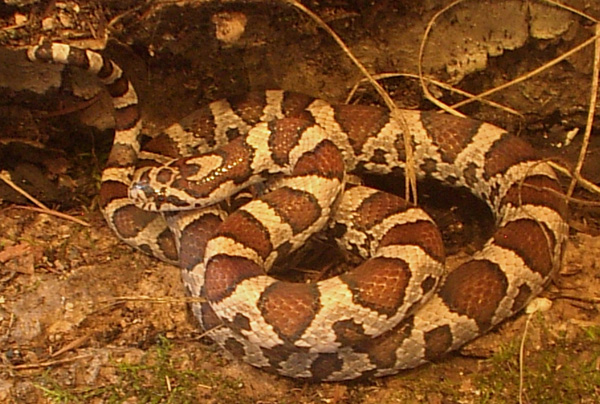
In Pennsylvania at least, the eastern milksnake is the subject of more tales and is more often mistakenly identified than any other snake. It is among the state's most beneficial snakes but is also the most often killed in mistake for a copperhead. Actually, there is only a superficial resemblance between these two snakes. The head of the copperhead is an easily recognized coppery color without any marks. The head of the milksnake is light with brownish marks. The belly of the copperhead is unmarked and a uniform cream or off-white. The belly of the milksnake is white with dark splotches resembling a checkerboard pattern.
The eastern milksnake, although considered to be more secretive than many other snakes, still is seen quite often. It appears in numbers throughout its range. Adults attain lengths of two to over four feet when fully grown.
NORTHERN WATERSNAKE
Nerodia sipedon sipedon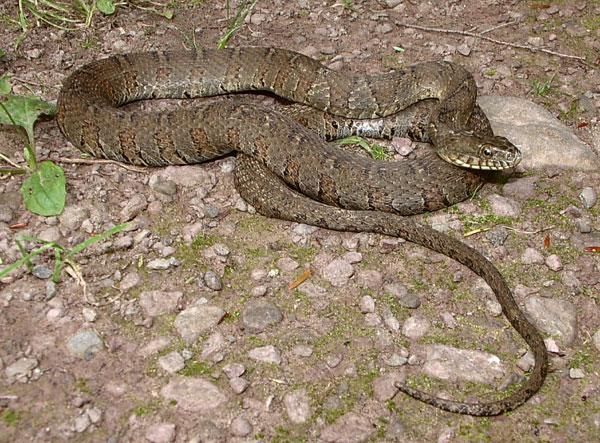
This is the largest of Pennsylvania's three water snakes, reaching an adult size that may range from 24 to over 50 inches. The male is usually smaller than the female.
Often killed by people out of fear, the northern watersnake is not a water moccasin and it is not venomous. The water moccasin, or cottonmouth, common to the South, is not found naturally in Pennsylvania and does not appear farther north than extreme southern Virginia.
The northern watersnake has a tendency to display a nasty disposition and becomes quite formidable when angered. It flattens its head and heavy body when striking. It flees if it can but strikes repeatedly if cornered. It has strong jaws, powerful enough to inflict a severe bite. Bites by the northern watersnake also may bleed profusely due to an anticoagulant quality of the snake's saliva. It does not inject a poisonous venom.
The northern watersnake is active both day and night and appears in sufficient numbers to be seen on a regular basis.
NORTHERN ROUGH GREENSNAKE
Opheodrys aestivus aestivus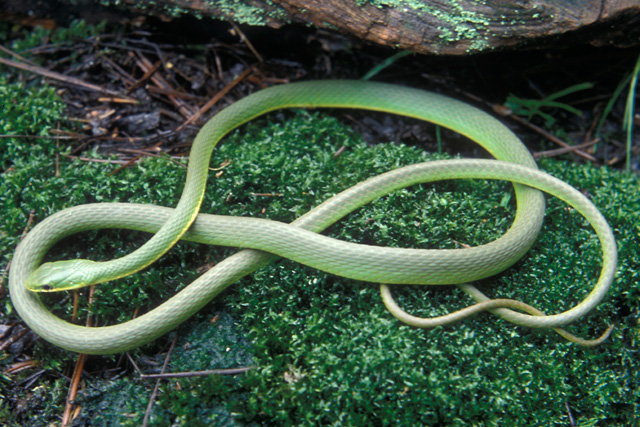
ENDANGERED SPECIES
It is easy to understand why this snake carries the nickname "vine snake," considering its color, slight build and penchant for climbing through brush. The rough greensnake is a graceful animal, liquid-like in its movements from one tree branch to another. It is mild-tempered and not easily aroused when confronted. At 22 to 32 inches, it is the largest of the state's two green snakes.
The rough greensnake has a slender body with a long, tapering tail. Its body is a consistent light or pale green throughout except for a white to yellowish-green belly. Its color is uniform throughout, and it has no markings. The divided anal plate is evident, and the scales are sharply keeled, hence its name, the rough green snake.
QUEENSNAKE
Regina septemvittata
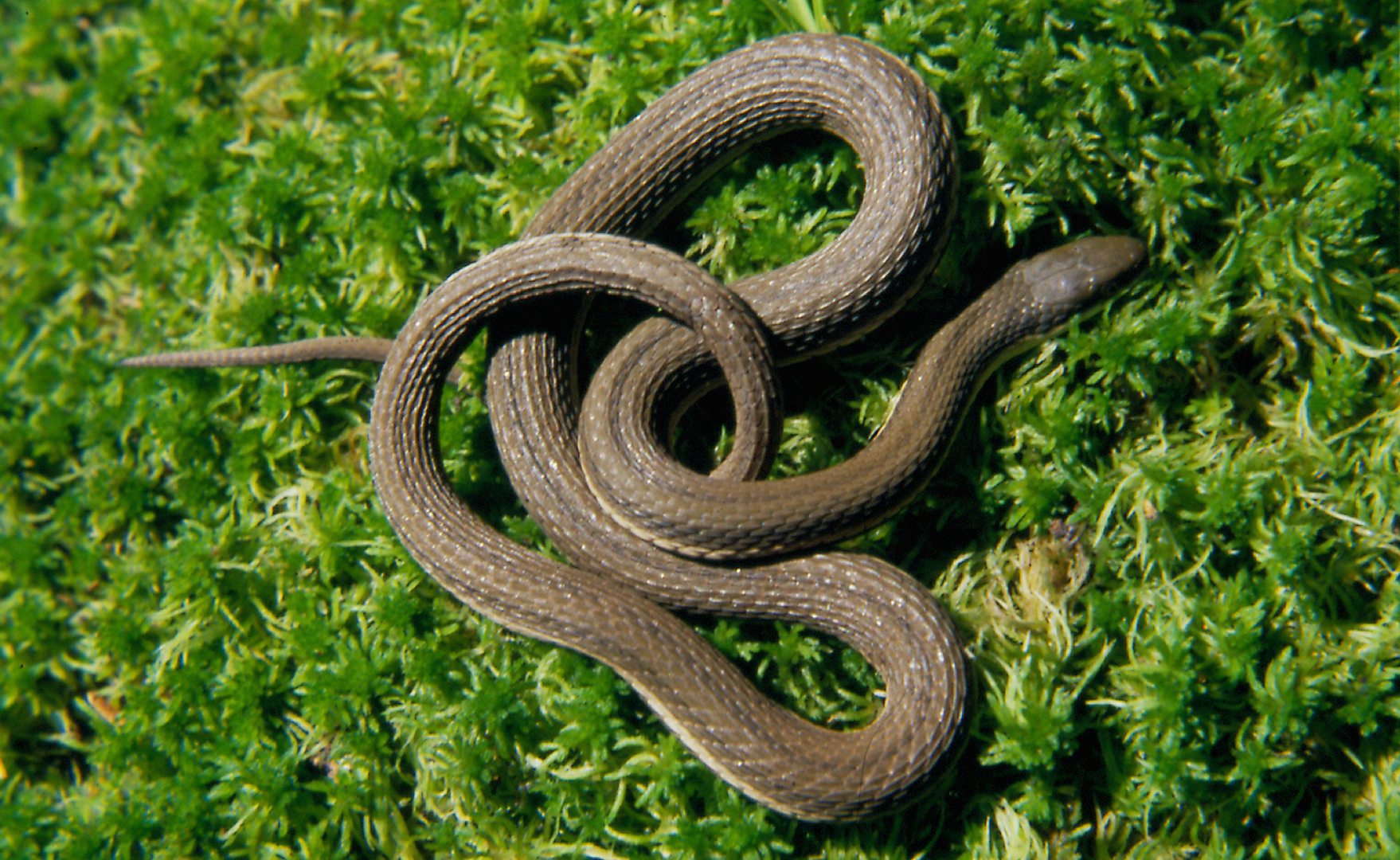 Another of Pennsylvania's snakes categorized as "water" snakes, the queensnake in some local areas may be known as the "willow" snake or "leather" snake. It is very much an aquatic animal and an excellent swimmer. If disturbed by an intruder it does not hesitate to slip quickly into the water for safety. Adult queensnakes are 15 to 36 inches in length.
Another of Pennsylvania's snakes categorized as "water" snakes, the queensnake in some local areas may be known as the "willow" snake or "leather" snake. It is very much an aquatic animal and an excellent swimmer. If disturbed by an intruder it does not hesitate to slip quickly into the water for safety. Adult queensnakes are 15 to 36 inches in length.
The queensnake is an attractive snake and a study in contrasts. The body color can be tan to shades of brown or almost black. A yellow stripe accents the lower side of the body and the belly is yellow with four well-defined brown stripes running its length. Two of these stripes are located near the center. Two larger stripes stretch along the sides of the belly. Some specimens may also have three faded stripes continuing down the back. The scales are keeled and the anal plate is divided.
DEKAY'S BROWNSNAKE
Storeria dekayi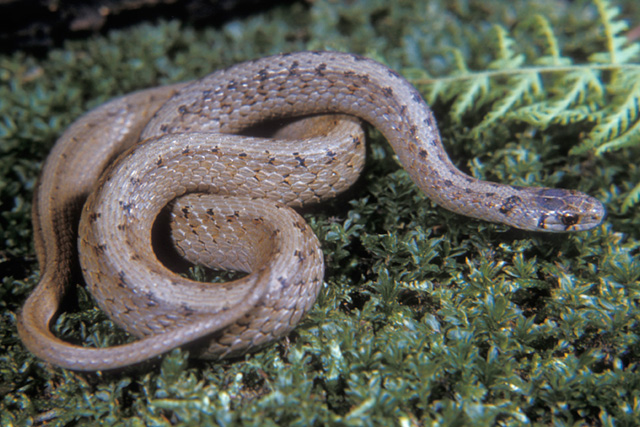
Like so many other snakes, Dekay's brownsnake is secretive, preferring to keep its whereabouts unknown. It is also one of the state's smallest snakes, reaching adult sizes of only nine to 13 inches. For the most part, Dekay's brownsnake is most active during the day. However, when warm weather sets in, it becomes more nocturnal, choosing to roam over its somewhat limited range after the sun has set.
Dekay's brownsnake is a small snake but with almost disproportionately large eyes. Its back and sides range in color from gray to yellowish brown, brown or reddish-brown. It has two parallel rows of small dark spots bordering a wide but indistinct stripe that runs down the center of the back for its full length. The belly can be pale yellow or brown, even pinkish, and it is edged with small black spots. In some specimens, a dark bar extends from just behind the eye downward to the upper lip. The scales of Dekay's brownsnake are keeled and the anal plate is divided.
RED-BELLIED SNAKE
Storeria occipitomaculata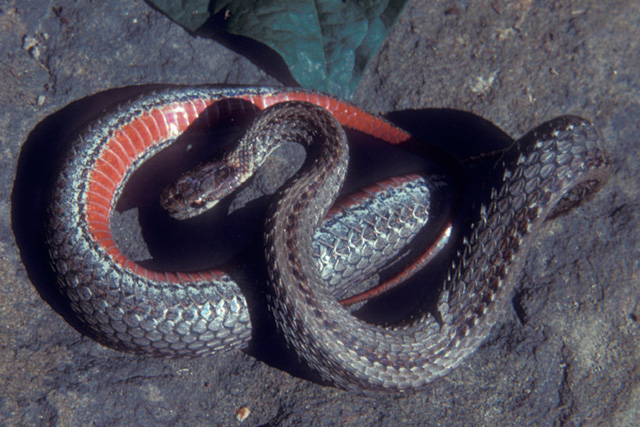
A snake of small proportions, the red-bellied snake rarely exceeds eight to 10 inches. It is secretive and often goes undetected by anglers and others who regularly spend time outdoors.
The red-bellied snake may be gray, black, brown or rusty red with stripes that vary in number. A single broad, light stripe may run down the back. Four faint, narrow, darker stripes may be present. In some cases, all five stripes appear. The head has a blackish cast over the body color, and there are three distinct light spots on the nape of the neck. The belly, reddish in most cases, also may be orange or yellow or even blue-black. The belly is unmarked and can be distinguished from Kirtland's snake, which has a double row of black spots down the belly. The scales are keeled and the anal plate is divided.
SHORT-HEADED GARTERSNAKE
Thamnophis brachystoma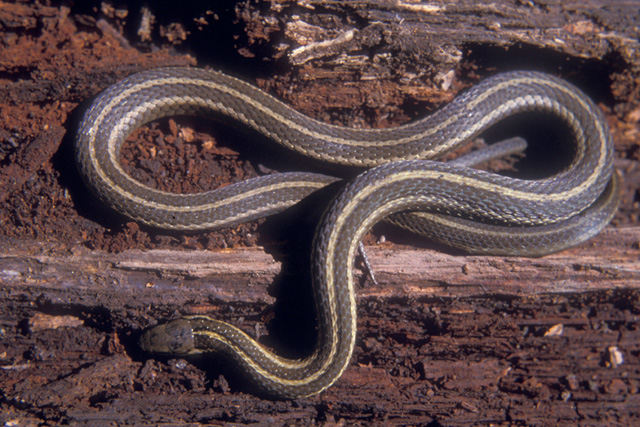
There are three garter snakes that make Pennsylvania their home, the eastern gartersnake, the short-headed gartersnake and the eastern ribbonsnake. The short-headed gartersnake, at 14 to 18 inches, averages a bit smaller in size than the eastern gartersnake and is not as widely distributed. Still, the short-headed gartersnake is quite common in its range. It congregates in large colonies.
Taking a clue from its name, one could correctly assume that the head is short. Most people would find it difficult to distinguish where the neck ends and the head begins because both are the same diameter. The short-headed gartersnake is blackish to dark shades of brown, accented with a well-defined light brownish or tan stripe down the middle of the back and a stripe along each side near the belly. At times, these side stripes are bordered by narrow black lines. The rows of black spots that occur between the stripes on other gartersnakes are absent on the short-headed gartersnake. The scales are keeled and the anal plate is single.
EASTERN RIBBONSNAKE
Thamnophis sauritus
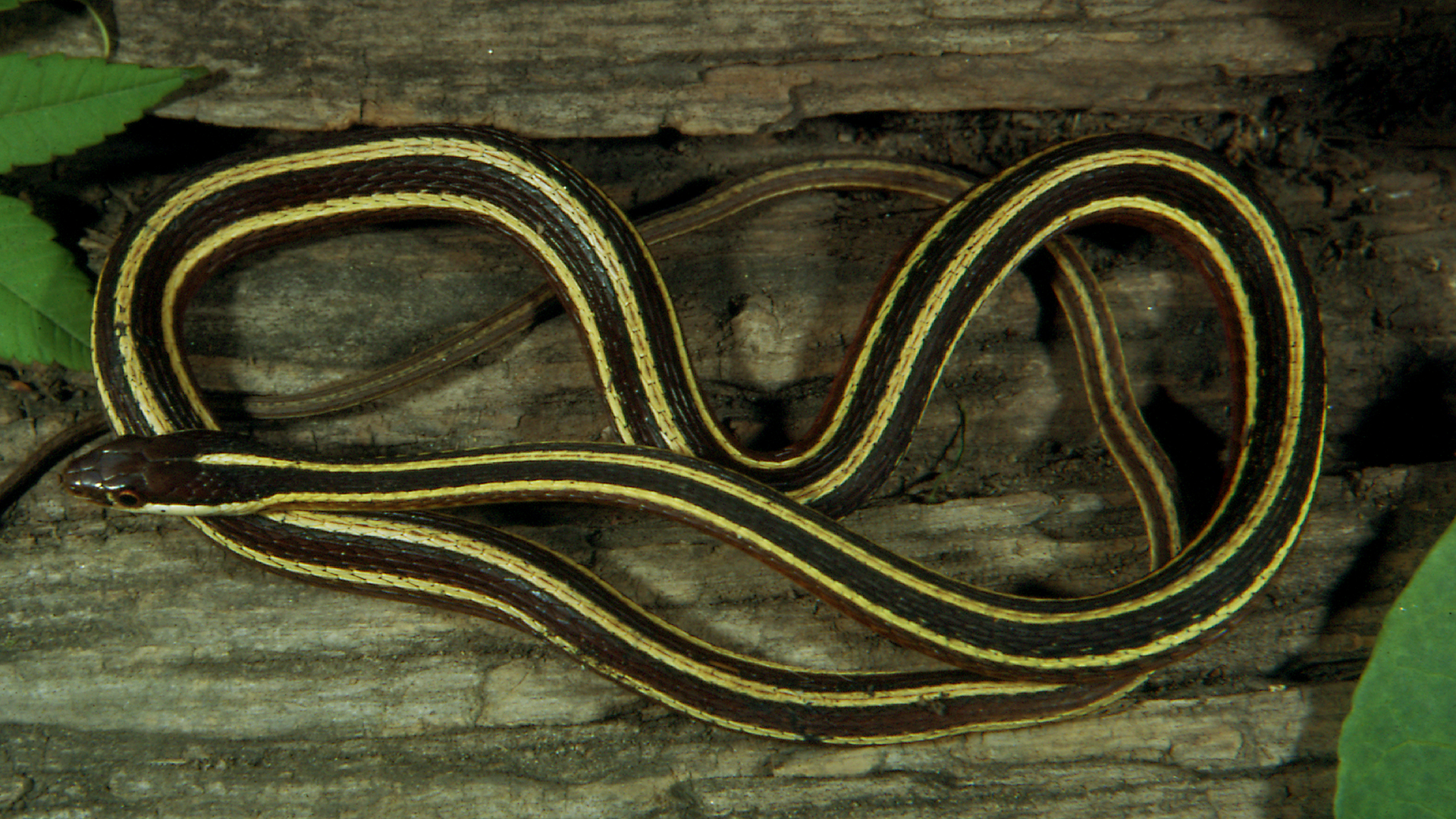 This animal is a close relative of the eastern gartersnake and short-headed gartersnake, but it is considered more aquatic. It attains a size equal to its cousin, the eastern gartersnake, roughly 18 to 26 inches. Very agile, the ribbonsnake moves quickly and with little effort through thick vegetation. In the water, the ribbonsnake glides swiftly across the surface. It rarely dives in the manner of true water snakes. Two subspecies are found in Pennsylvania.
This animal is a close relative of the eastern gartersnake and short-headed gartersnake, but it is considered more aquatic. It attains a size equal to its cousin, the eastern gartersnake, roughly 18 to 26 inches. Very agile, the ribbonsnake moves quickly and with little effort through thick vegetation. In the water, the ribbonsnake glides swiftly across the surface. It rarely dives in the manner of true water snakes. Two subspecies are found in Pennsylvania.
This snake is slender, with fluid lines and a tail that is quite long. Three bright-yellow stripes, one on the back and one on each side, contrast sharply with a black body. A dark-brownish stripe marks the margin of the belly. The belly itself is yellowish or greenish and has no markings. There appears just a touch of yellow under each eye. Close examination reveals keeled scales and a single anal plate.
EASTERN GARTERSNAKE
Thamnopnis sirtalis sirtalis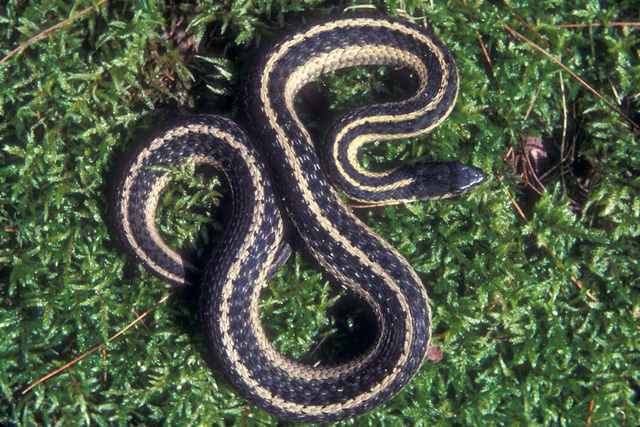
The chances are very good that anyone who has spent any time at all outdoors has seen an eastern gartersnake at least once. It is the most widely distributed and familiar snake in North America. Adults attain lengths of 18 to 26 inches, a bit larger than the short-headed gartersnake but about equal to the ribbonsnake, a close cousin.
Doing most of its traveling and foraging during the day, the eastern gartersnake is active over a longer period than most other snakes. Able to tolerate colder temperatures, it leaves the den first in the spring and it's the last to hibernate in the fall.
The eastern gartersnake is dark greenish to black across the body. Stripes, normally three, trail down the back and sides. They can be yellowish to brown or greenish but usually are well-defined. A double row of spots commonly appears between the stripes. The belly of the eastern gartersnake varies from greenish to shades of yellow and includes two rows of indistinct black spots. Like the short-headed gartersnake, the eastern gartersnake displays keeled scales and a single anal plate.
EASTERN SMOOTH EARTHSNAKE
Virginia valeriae valeriae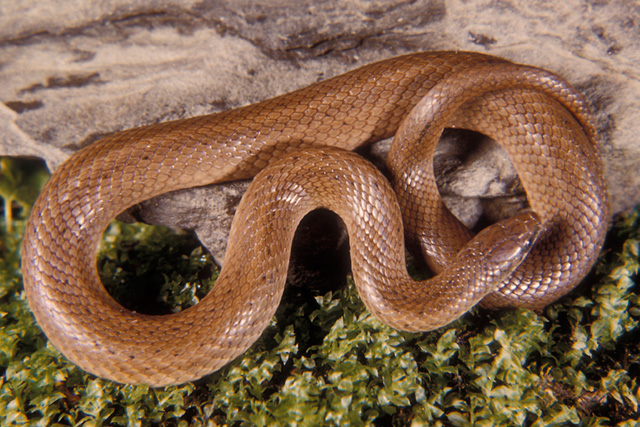
At a maximum seven to 10 inches long, the smooth earthsnake competes with the eastern wormsnake for the "smallest snake in the state" title. A good time to look for the smooth earthsnake is immediately after a rainfall. It seems to enjoy a moist if not wet environment.
The smooth earthsnake is reddish brown to gray and has no distinctive markings other than possibly widely scattered small dark flecks in rows on the back. The belly is unmarked and can be grayish, off-white or yellowish. On occasional specimens there may be a dark area between the eye and nostril. The scales are smooth on the eastern earth snake and very slightly keeled on the mountain earth snake. The anal plate is divided.
MOUNTAIN EARTHSNAKE
Virginia valeriae pulchra
SMOOTH GREENSNAKE
Opheodrys vernalis
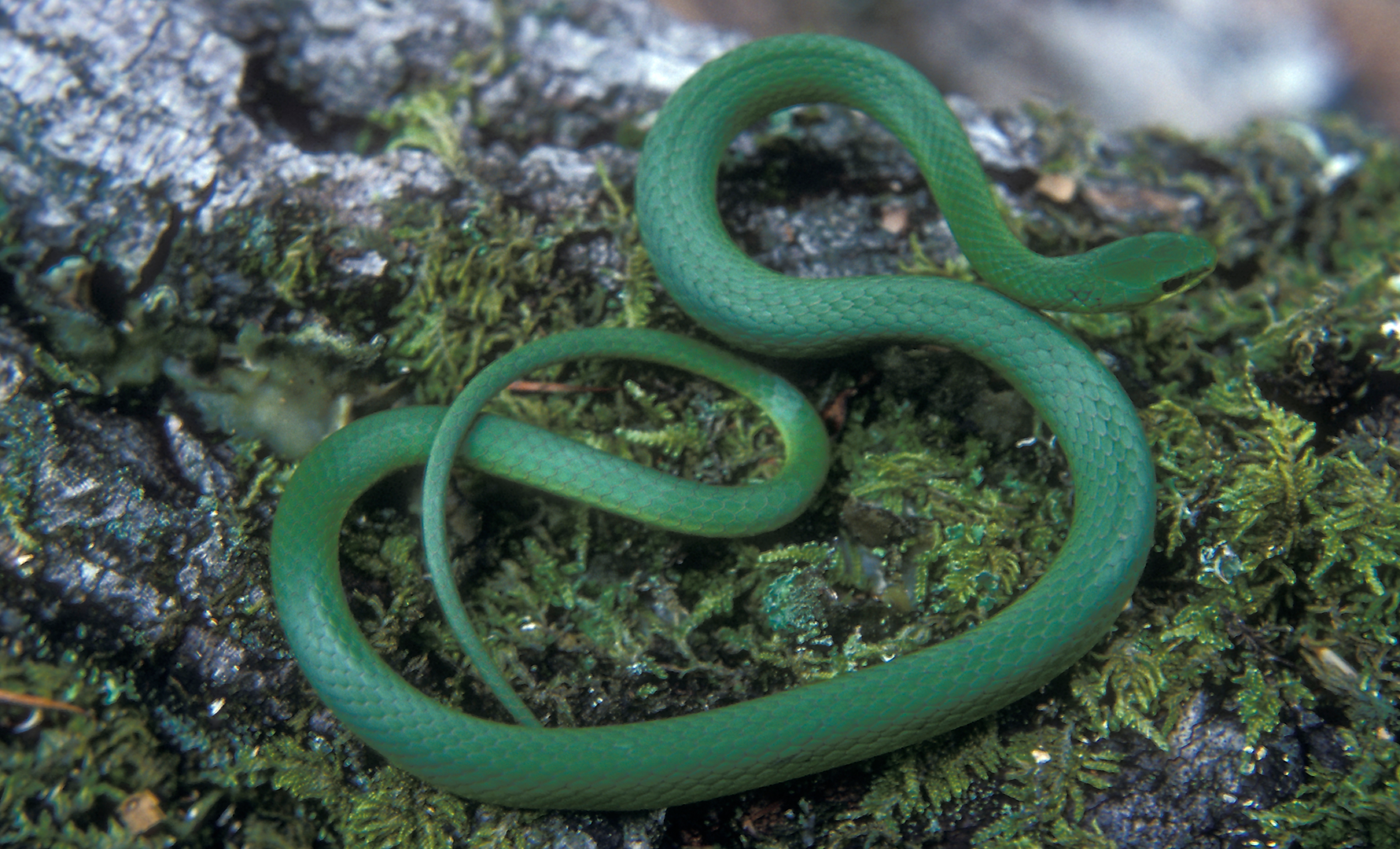 Commonly known as the "green grass snake," the smooth greensnake spends most of its time on the ground. It is the terrestrial cousin of the arboreal rough greensnake and is slightly smaller. Adult sizes range from 14 to 20 inches. It is said to be the most gentle of all North American snakes.
Commonly known as the "green grass snake," the smooth greensnake spends most of its time on the ground. It is the terrestrial cousin of the arboreal rough greensnake and is slightly smaller. Adult sizes range from 14 to 20 inches. It is said to be the most gentle of all North American snakes.
The eastern smooth green snake is small and streamlined in appearance with the body ending in a long, tapered tail. Its body is a bright grass-green above with a plain white belly tinged with just a touch of pale yellow. The anal plate is divided and the smooth scales (keeled scales on the rough green snake) depict the name of the smooth greensnake.
EASTERN COPPERHEAD
Agkistrodon contortrix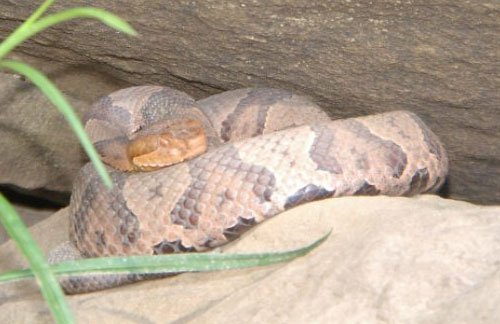
One of only three venomous snakes common to Pennsylvania, the eastern copperhead is a close cousin of the cottonmouth or water moccasin found in more southerly aquatic environments. Reflecting its preferred habitat, the copperhead sometimes is referred to as the "upland" or "highland" moccasin. However, the cottonmouth is not indigenous to Pennsylvania.
The copperhead is a quiet creature — some would say almost lethargic — and usually does its best to avoid trouble, quietly stealing to a safe retreat whenever it can. If threatened, and it feels the need to protect itself, the copperhead is capable of striking out most vigorously. If the strike hits its intended victim, poison may be injected through two hollow fangs connected to glands located on each side and toward the rear of the head. The venom-injecting apparatus is similar to that found in the rattlesnake, although the copperhead's fangs tend to be a bit shorter. The venom is a hemotoxin, but with a trace of neurotoxin and as such primarily affects the bloodstream. The bite and resultant injection of venom is painful. But with prompt medical attention, it seldom poses any serious threat to life.
The copperhead, reaching an average adult size of 24 to 36 inches, is a stout-bodied snake, perhaps heavier than most harmless snakes of a similar length. The body color is copper or hazel-brown, sometimes accented with a tinge of pink or orange. Bold chestnut or reddish-brown crossbands are narrowest across the midline of the back and wider at the sides. They present the appearance of a dark hourglass if one imagines them stretched out flat. There may be small, dark spots between these bands. The crossband patterns on the copperhead are dark, but on the milksnake, a snake often confused with the copperhead, the hourglass-shaped cross-bands are a lighter color. Thus, the dark pattern on the milksnake is at its widest across the midline of the back, compared to the narrower dark band on the midline of the copperhead.
The belly of the copperhead is a mottled pattern of white to gray. This feature also can be used as an aid in separating the copperhead from the milksnake, which has a black and white belly pattern roughly resembling a checkerboard. The unmarked head, somewhat triangular, is covered with large copper-colored scales.
The pupil of the eye is vertically elliptical (similar to a cat's pupil). It is a feature that can be used to distinguish all of Pennsylvania's venomous from its non-venomous snakes. The pupil is rounded on the non-venomous snakes common to Pennsylvania. The copperhead also has the facial pit located between the eye and nostril, common to Pennsylvania's three venomous snakes. This heat-sensitive organ is missing from the non-venomous species in Pennsylvania.
TIMBER RATTLESNAKE
Crotalus horridus
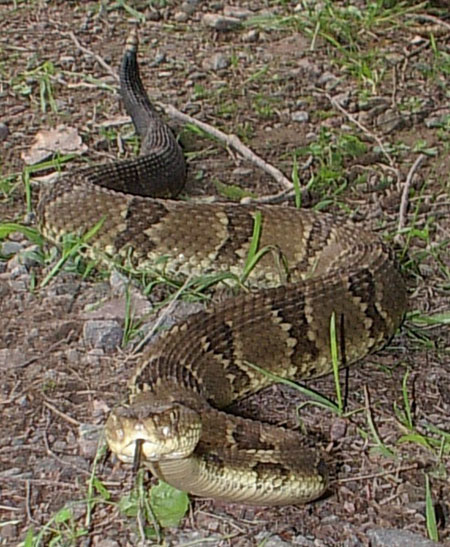
Though not the largest snake found in Pennsylvania, the timber rattlesnake has the distinction of being the largest of our three venomous species. It may reach adult sizes of 36 to 54 inches. It is sometimes called the "banded" rattlesnake or "velvet-tail" rattler.
Like the copperhead and other snakes, the timber rattlesnake would just as soon be left alone. It is not an aggressive creature. The timber rattler is prone to lie quietly or crawl away to safety if given the chance.
The timber rattler stands its ground (like many other animals) if it feels threatened and unable to escape. When striking, venom may be released from glands located in the head and injected into the victim through modified front teeth referred to as fangs. It should be noted that a defensive strike does not always include a release of venom. Venom primarily is used to disable prey.
Contrary to popular belief, the timber rattlesnake does not always sound its familiar alarm before striking. In fact, when striking because of fear or the need to defend itself, more often than not the snake strikes without an audible warning. The "rattle," from which this snake obviously gets its name, is an organ of loosely attached, hollow horny segments fastened to the tail. Rapidly vibrating the tail causes these button-like segments to strike one another, producing an unmistakable buzzing sound. The rattle may grow by two to four segments annually, because new segments are added each time the skin is shed. Thus, the number of segments on the rattle, or "cloche," as it is called, cannot be used to determine the age of the snake. However, the larger the snake, the louder the buzzing.
Timber rattlesnakes are found in two different color phases, black and the less common yellow phase. Each phase is permanent. Coloration does not change from one phase to the other on any individual snake. On a yellow specimen, black or dark-brown crossbands contrast against a yellow background that might range from dull to a deep lemon. In some cases, the "yellow" tends to be brownish or grayish, but always lighter than the black phase. The crossbands are often V-shaped and tend to break up toward the rear of the body to form a row of dark spots down the back and along each side.
The more common black phase timber rattlers have a heavy stipling or flecking of very dark browns or blacks that covers most of the lighter or yellowish pigments. Completely black specimens are not all that rare in some areas.
EASTERN MASSASAUGA
Sistrurus catenatus
ENDANGERED SPECIES - SPECIES ACTION PLAN
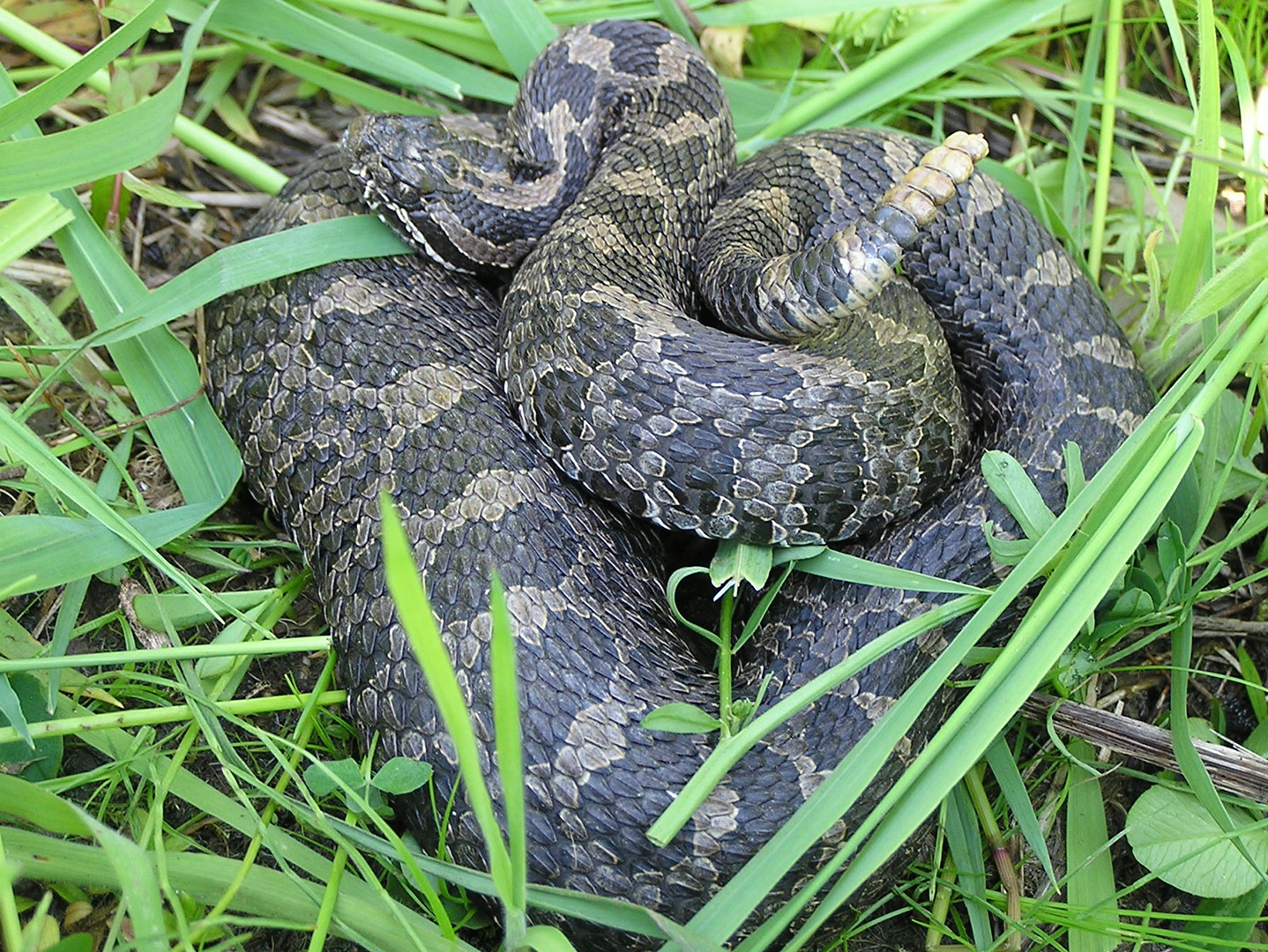 The eastern massasauga is a rattlesnake. It is the smallest of Pennsylvania's three venomous snakes, but the one with the biggest problem. Reflecting concern for its dwindling numbers, this reptile has been placed on Pennsylvania's List of Endangered Species. It is illegal to possess, kill, sell or offer for sale this or any other animal on the endangered list.
The eastern massasauga is a rattlesnake. It is the smallest of Pennsylvania's three venomous snakes, but the one with the biggest problem. Reflecting concern for its dwindling numbers, this reptile has been placed on Pennsylvania's List of Endangered Species. It is illegal to possess, kill, sell or offer for sale this or any other animal on the endangered list.
The biggest problem facing this small rattlesnake is loss of habitat. A resident of swampy areas, much of its habitat has been drained or dried up. In some cases, new or widened highways encroached into its wet domain and with each new lane of traffic, acres of vital habitat were lost. Its common name, massasauga, is said to be derived from a Chippewa Indian word meaning great river mouth. It alludes to what was typical Chippewa country, which often included swampland surrounding the mouths of rivers.
Reflecting its preferred habitat, the massasauga rattlesnake sometimes is referred to as the "swamp" rattler. It does not grow much larger than 20 to 30 inches.
The massasauga is brownish gray to almost black on its back and sides with a row of rounded, dark-brown or black blotches running down the middle of the back. Usually three rows of smaller and lighter blotches or spots stretch along each side. A dark bar, bordered with a lighter color, extends from the eye to the rear of the jaw, and several dark bars start at the top of the head and flow onto the neck. The facial pit is in its usual position between the eye and nostril. The belly is black with scattered white or yellowish markings. Nine plates (actually large scales) cover the crown of the head, compared to the timber rattlesnake's numerous small scales. The tail is stocky or stout, ending in a moderately developed rattle. The underside of the tail has a single row of scales, similar to the other venomous snakes in Pennsylvania. The anal plate is single; the scales over the back are keeled.
The Pennsylvania Amphibian and Reptile Survey (PARS) helps determine the distribution and status of all amphibians and reptiles, including snakes, throughout Pennsylvania.